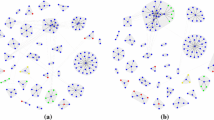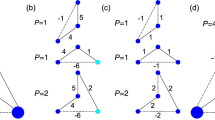Abstract
This paper studies two clique relaxation models, k-blocks and k-robust 2-clubs, used to describe structurally cohesive clusters with good robustness and reachability properties. The minimization version of the two problems are shown to be hard to approximate for \(k \ge 3\) and \(k \ge 4\), respectively. Integer programming formulations are proposed and a polyhedral study is presented. The results of sample numerical experiments on several graph instances are also reported.


Similar content being viewed by others
Notes
The original definition of k-block according to Matula (1978) requires maximality and corresponds to maximal k-block in our terminology.
References
Alimonti, P., & Kann, V. (2000). Some APX-completeness results for cubic graphs. Theoretical Computer Science, 237, 123–134.
Amini, O., Peleg, D., Pérennes, S., Sau, I., & Saurabh, S. (2012). On the approximability of some degree-constrained subgraph problems. Discrete Applied Mathematics, 160, 1661–1679.
Balasundaram, B., Butenko, S., & Trukhanov, S. (2005). Novel approaches for analyzing biological networks. Journal of Combinatorial Optimization, 10, 23–39.
Chartrand, G., Kaugars, A., & Lick, D. R. (1972). Critically \(n\)-connected graphs. Proceedings of the American Mathematical Society, 32, 63–68.
Chen, Y. P., Liestman, A. L., & Liu, J. (2005). Clustering algorithms for ad hoc wireless networks. In Y. Pan & Y. Xiao (Eds.), Ad hoc and sensor networks, wireless networks and mobile computing (pp. 145–164). New York: Nova Science Publishers.
COLOR02/03/04: Graph Coloring and its Generalizaions. http://mat.gsia.cmu.edu/COLOR03/. Accessed August 2015
Diestel, R. (2010). Graph theory (4th ed.). Heidelberg: Springer.
Dimacs (1995) Cliques, coloring, and satisfiability: Second dimacs implementation challenge. http://dimacs.rutgers.edu/Challenges/. Accessed August 2015
Dimacs (2011) Graph partitioning and graph clustering: Tenth dimacs implementation challenge. http://www.cc.gatech.edu/dimacs10/index.shtml. Accessed August 2015
Erdös, P., & Rényi, A. (1959). On random graphs. Publicationes Mathematicae (Debrecen), 6, 290–297.
Faudree, R. J., Gould, R. J., & Powell, J. S. (2012). Property \(P_{d, m}\) and efficient design of reliable networks. Networks, 60(3), 167–178.
Feige, U. (2003). Vertex cover is hardest to approximate on regular graphs. Technical report MCS 03-15, Weizmann Institute
FICO\(^{{\rm TM}}\). (2014). Xpress Optimization Suite 7.7. http://www.fico.com. Accessed August 2015
Kirousis, L. M., Serna, M., & Spirakis, P. (1993). Parallel complexity of the connected subgraph problem. SIAM Journal on Computing, 22, 573–586.
Liaw, S.-C., & Chang, G. J. (1998). Generalized diameters and Rabin numbers of networks. Journal of Combinatorial Optimization, 2(4), 371–384.
Luce, R., & Perry, A. (1949). A method of matrix analysis of group structure. Psychometrika, 14, 95–116.
Ma, C., Kim, D., Wang, Y., Wang, W., Sohaee, N., & Wu, W. (2010). Hardness of \(k\)-vertex-connected subgraph augmentation problem. Journal of Combinatorial Optimization, 20(3), 249–258.
Matula, D. W. (1978). \(k\)-Blocks and ultrablocks in graphs. Journal of Combinatorial Theory, Series B, 24, 1–13.
Moody, J., & White, D. R. (2003). Structural cohesion and embeddedness: A hierarchical concept of social groups. American Sociological Review, 68, 103–127.
Papadimitriou, C. H., & Yannakakis, M. (1991). Optimization, approximation, and complexity classes. Journal of Computer and System Sciences, 43(3), 425–440.
Pattillo, J., Youssef, N., & Butenko, S. (2013). On clique relaxation models in network analysis. European Journal of Operational Research, 226, 9–18.
Raghavan, S. (1995). Formulations and algorithms for network design problems with connectivity requirements. PhD thesis, Massachusetts Institute of Technology
Raz, R., & Safra, S. (1997). A sub-constant error-probability low-degree test, and a sub-constant error-probability pcp characterization of NP. In Proceedings of the 29th ACM symposium on theory of computing, El Paso (pp. 475–484)
Vazirani, V. V. (2001). Approximation algorithms. New York: Springer.
Veremyev, A., Prokopyev, O. A., Boginski, V., & Pasiliao, E. L. (2014). Finding maximum subgraphs with relatively large vertex connectivity. European Journal of Operational Research, 239(2), 349–362.
Veremyev, A., & Boginski, V. (2012). Robustness and strong attack tolerance of low-diameter networks. Dynamics of Information Systems: Mathematical Foundations. Springer Proceedings in Mathematics & Statistics, 20, 137–156.
Veremyev, A., & Boginski, V. (2012). Identifying large robust network clusters via new compact formulations of maximum \(k\)-club problems. European Journal of Operational Research, 218, 316–326.
Verma, A., Buchanan, A., & Butenko, S. (2015). Solving the maximum clique and vertex coloring problems on very large sparse networks. INFORMS Journal on Computing, 27, 164–177.
Yin, J.-H., Li, J.-S., Chen, G.-L., & Zhong, C. (2005). On the fault-tolerant diameter and wide diameter of \(\omega \)-connected graphs. Networks, 45(2), 88–94.
Acknowledgments
The authors would like to thank the three anonymous referees and guest editors for their valuable comments and suggestions that helped improve the content and presentation of this paper. This material is based upon work supported by the AFRL Mathematical Modeling and Optimization Institute. Partial support by AFOSR under Grants FA9550-12-1-0103 and FA8651-12-2-0011 is also gratefully acknowledged.
Author information
Authors and Affiliations
Corresponding author
Appendix: Proof of Proposition 1
Appendix: Proof of Proposition 1
We use the notion of L-reduction (Papadimitriou and Yannakakis 1991) defined next, that is widely used for establishing APX-hardness results. Given two optimization problems F and G, we say that F L-reduces to G if there are two polynomial-time algorithms f, g and constants \(\alpha , \beta >0\) such that for each instance x of F:
-
1.
f produces an instance f(x) of G, such that \(OPT_G(f(x)) \le \alpha OPT_F(x)\).
-
2.
Given any solution of f(x) with cost \(c'\), g produces a solution of x with cost c such that \(|c-OPT_F(x)| \le \beta |c' - OPT_G(f(x))|\).
If F L-reduces to G and there is a polynomial-time approximation algorithm for G with worst-case error \(\epsilon \), then there is a polynomial-time approximation algorithm for F with worst-case error \(\alpha \beta \epsilon \). We now give the following L-reduction f from Min Vertex Cover on 3-regular graphs to Min Vertex Cover on k-regular graphs, \(k \ge 4\). Given a 3-regular graph \(G=(V,E)\) construct a k-regular graph \(G'=(V',E')\) as follows. Let \(|V(G)|=n\). Consider k identical copies \(G_1,G_2,\ldots ,G_k\) of G. Denote the vertex set and edge set of the \(r^{th}\) such copy respectively by \(V_r\) and \(E_r, r = 1,\ldots ,k\), where \(V_r = \{1_r,\ldots ,n_r\}\) and \(E_r = \{(i_r,j_r): (i,j) \in E(G)\}\). Let \(R = \cup _{r=1}^{k}V_r\) and \(E_R = \cup _{r=1}^{k}E_r\). For each \(v \in V(G)\) consider a set of \((k-3)\) independent vertices \(P_v =\{u^v_1,\ldots ,u^v_{k-3}\}\), and let \(P = \cup _{v \in V}P_v\). Put \(V' = R \cup P\) and \(E' = E_R \cup E_P\), where
That is for each \(v \in V\), there is an edge between \(v_r\) and \(u^v_j\) for \(j=1,\ldots ,k-3\) and \(r=1,\ldots ,k\). This completes the construction of \(G'=(V',E')\).
It is easy to see that from every vertex cover \(C \subseteq V\) of G we can construct a vertex cover \(C' \subseteq V'\) of \(G'\) of size exactly \(n(k-3)+3|C|\), by choosing \(v_r \in V_r, r = 1,\ldots ,k\) if \(v \in C\) and by choosing the set \(P_v\) if \(v \notin C\). Since G is 3-regular we have \(n = |V| \le |E| \le \sum _{v \in C}deg(v) = 3|C|\). Then, \(|C'| = n(k-3) + 3|C| \le 3(k-3)|C| + 3|C| = 3(k-2)|C|\) and, this satisfies the first property of L-reduction with \(\alpha =3(k-2)\).
Conversely, given any vertex cover \(C' \subseteq V'\) of \(G'\), we can transform it back to a vertex cover \(C \subseteq V\) of G as follows. First note that if \(v_r \notin C'\) for some \(r \in \{1,\ldots ,k\}\), then \(P_v\subseteq C'\). Hence given any vertex cover \(C'\), if \(C_1,C_2,\ldots ,C_k \subseteq C'\) are the subsets of vertices selected respectively from \(V_1,\ldots ,V_k\), then \(C_i\) must be a vertex cover of \(G_i\) for each \(i \in \{1,\ldots ,k\}\) and hence, the corresponding vertices in V must be a vertex cover of G. Let h be such that \(|C_h|= \min \{|C_1|,\ldots ,|C_k|\}\). Then \(C=\{v \in V: v_h \in C_h\}\) is a vertex cover of G and \(|C| \le \frac{1}{3}(|C'| -n(k-3))\). Together with the observation \(|OPT_{VC}(G')| \le 3|OPT_{VC}(G)| + n(k-3)\) from the previous paragraph, it is easy to see that f is a L-reduction with \(\beta = 1\). \(\square \)
Rights and permissions
About this article
Cite this article
Balasubramaniam, C., Butenko, S. On robust clusters of minimum cardinality in networks. Ann Oper Res 249, 17–37 (2017). https://doi.org/10.1007/s10479-015-1992-4
Published:
Issue Date:
DOI: https://doi.org/10.1007/s10479-015-1992-4




